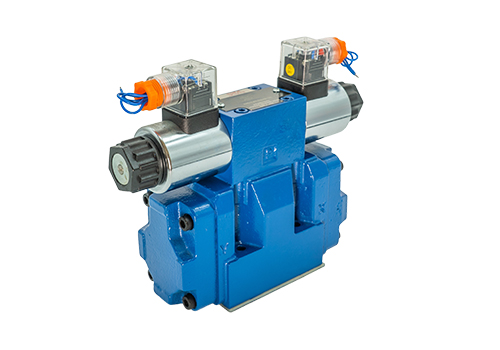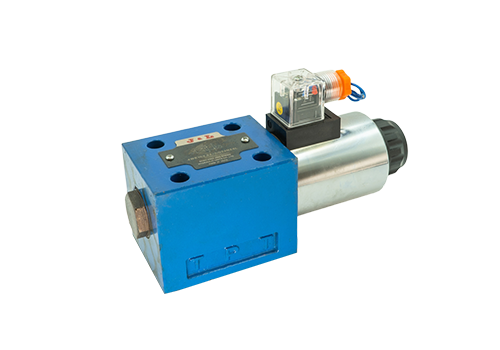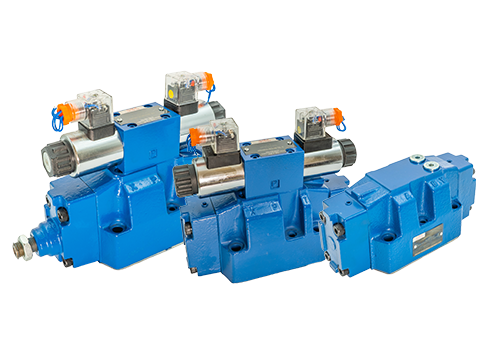
2025-08-20 4WE10 solenoid reversing valve is a solenoid-operated reversing valve, which is mainly used to control the opening, stop and reversing of liquid flow in the hydraulic system, and realize the movement control of hydraulic components or the flow direction adjustment. Its core function and working principle are as follows: 1. The core action direction control changes the valve core position through the on-off of the solenoid, thereby switching the flow path of hydraulic oil (such as P→A, B→T or P→B, A→T), and realizing the forward and reverse rotation or direction switching of actuators (such as hydraulic cylinders, hydraulic motors). Flow adjustment In some applications, by adjusting the valve core opening or matching the throttle valve, the flow of hydraulic oil can be controlled, and the movement speed of the actuator can be adjusted. System protection When the hydraulic system is overloaded or malfunctioned, the oil circuit can be cut off through the reversing valve to protect the safety of the equipment. 2. Working principle and structure composition 4WE10 solenoid reversing valve is mainly composed of the main valve body, valve core, return spring, solenoid (pilot valve) and other parts. Valve core
Read More 
2025-08-18 The superimposed relief valve is a hydraulic control element that integrates the overflow function and modular design characteristics. It is widely used in hydraulic systems to achieve pressure regulation, overload protection and system pressure stabilization. Its working principle combines the core mechanism of the pilot relief valve and the compact structural advantages of the superimposed valve. The following details are explained from four aspects: structural composition, working process, characteristic analysis and typical applications: 1. Structural composition: Modular layered design Superimposed relief valve is composed of multiple functional modules superimposed by bolts, each module undertakes a specific function. The typical structure includes: main valve module: main valve core: conical or spherical structure, which cooperates with the valve seat to control the opening and breakage of the main oil passage. Spring chamber: Built-in pressure regulating spring to provide the preload force required for the main valve core to close. Pilot valve module: Pilot valve core: small conical valve, controlling the pilot oil circuit pressure. Pressure regulating screw: Change the compression amount of the pilot spring by rotation to set the system pressure. Superimposed base plate: Provides standard installation interface (such as I
Read More 
2025-08-16 4WE10 single-head solenoid reversing valve is a common hydraulic control element. It belongs to the wet solenoid reversing valve series. It is produced by German Rexroth and other manufacturers and is widely used in industrial hydraulic systems. Its core function is to control the flow direction of hydraulic oil through electromagnetic force to realize the reversal, start, stop or speed adjustment of actuators (such as hydraulic cylinders and hydraulic motors). The following is the specific application scope and characteristics analysis: 1. Core application areas 1. Engineering machinery application scenarios: hydraulic systems of excavators, loaders, road rollers and other equipment. Function: Control the expansion and contraction of the hydraulic cylinder (such as the lifting and lowering of the boom and bucket) to realize the reversing action of the working device. Advantages: fast response speed (usually ≤ 50ms), strong anti-pollution ability, suitable for harsh working conditions. 2. Application scenarios of plastic machinery: hydraulic systems of injection molding machines, extruders, and blow molding machines. Function: Control the opening and closing of the mold, the action of the ejection mechanism, and the hydraulic motor
Read More 
2025-08-14 The superimposed hydraulic control check valve is a hydraulic component that combines the function of the hydraulic control check valve with the design concept of the superimposed valve. It has the characteristics of compact structure, convenient installation, high integration and flexible control. It is widely used in hydraulic systems where one-way locking, pressure holding or reverse opening is required. The following is a detailed analysis of its structural characteristics: 1. Overall structural features, superimposed design modular structure: consists of valve body, control cover plate, spring, valve core, seal and other components. Each functional module (such as one-way valve, control oil circuit) is integrated into one valve body and is installed vertically through a standard installation surface (such as ISO 4401 or DIN 24340) with other superimposed valves (such as reversing valves, pressure valves). Installation convenience: No separate pipe is required, it is directly fixed to the bottom plate of the valve group by bolts, reducing leakage points and shortening system assembly time. Standard ports for multi-port configuration: usually include oil inlet (P), oil outlet (A), and control port (X)
Read More 
2025-08-11 4WEH16 electro-hydraulic reversing valve is a reversing valve that combines electromagnetic control and hydraulic drive. It is widely used in industrial hydraulic systems and is used to control the flow direction, pressure or flow rate of oil. Its installation must strictly follow specifications to ensure stable performance and avoid leakage or failure. The following are detailed installation steps and precautions: 1. Prepare the environment to check the cleanliness before installation: The installation area must be free of dust, oil, metal chips and other impurities to avoid entering the valve body and causing stagnation or wear. Temperature and humidity: The ambient temperature should be between -10℃~+50℃, and the humidity should be ≤85%, to prevent electrical components from getting damp or hydraulic oil from solidifying. Vibration and impact: Avoid installation near vibration sources (such as motors, pumps) to prevent valve core from being offset or damaged due to vibration. Equipment checks the appearance of the valve body: Check that the valve body, solenoid, pilot valve and other components are free of cracks, deformation or bump damage. Seals: Make sure that O-rings, gaskets, etc. are not aging or damaged, and replace new parts if necessary.
Read More 
2025-08-05 The superimposed relief valve is a hydraulic control element that integrates the overflow function with the superimposed valve plate. It is widely used in hydraulic systems for pressure regulation, overload protection and system unloading. Its common faults are usually related to pressure instability, leakage, abnormal noise or failure of operation. The following details are explained in detail from three aspects: failure phenomenon, cause analysis and removal methods: 1. Pressure instability (system pressure fluctuates or cannot reach the set value) Fault phenomenon The system pressure fluctuates and is unable to stabilize at the set value. The actuator (such as a hydraulic cylinder) acts slowly or shakes. Cause analysis: The spring is fatigued or broken due to pressure regulating spring, resulting in insufficient preload. The spring seat is loose or stuck, affecting pressure regulation. Spool malfunctions The valve core is worn or woven, causing leakage or stagnation. The conical surface of the valve core is not tightly sealed, causing internal leakage. The damping hole blocks the damping hole is blocked by impurities in the oil, affecting pressure feedback. Oil contaminates the oil to mix particles, moisture or air, resulting in
Read More 




